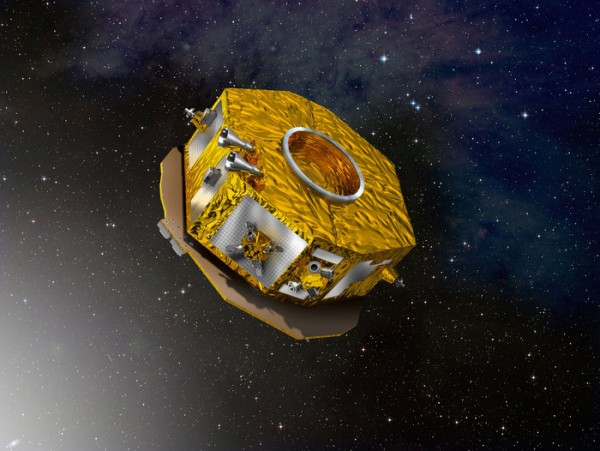This Spacecraft Can Now Detect Ripples in Spacetime and Gravitational Waves
| Ana Verayo | | Jun 08, 2016 02:30 AM EDT |
(Photo : ESA–D. Ducros, 2010) Artist's impression of LISA Pathfinder.
An incredible new space mission involving the detection of gravitational waves in space is already operating for some months after its launch, as European Space Agency revealed some record breaking observations of spacetime rippling over the course of two months.
Like Us on Facebook
The European Space Agency's LISA Pathfinder satellite was first placed into orbit for testing a state of the art laser measurement system for another space observatory, and after successfully detecting gravitational waves, the probe is now on the verge of finding evidence of merging supermassive black holes.
Inside this spacecraft lies two gold-platinum cubes measuring 4.6 centimeters each which are suspended in space which can only by influenced by gravity in space and no other external cosmic force, according to ESA officials. They also have been able to maintain in a very still, undistrubed position, where LISA also possesses fives time more accuracy than previously set by mission scientists.
According co-principal investigator, Karsten Danzmann from the Max Planck Institute for Gravitational Physics, during commissioning, the requirements were already complete and being met already. The team did not tweak or adjust any settings where we only wanted to see if the laser was working as planned and the evidence was there, as the performance just became better every time ever since.
Scientists were ecstatic about LISA Pathfinder's incredible ability to detect gravitational waves in a more reliable manner as these ripples are so elusive and challenging to detect, where the existence of gravitational waves were first confirmed last year by the Laser Interferometer Gravitational-Wave Observatory or LIGO on ground observatories.
This discovery was such a milestone in the field of science of physics and is also considered as one of the greatest scientific discoveries yet, where the goal of this mission is to use this ability and detect gravitational waves in actual space as opposed to ground observatories.
Last December, ESA launched the LISA Pathfinder in order to test these cubes that are released by the satellite during a free fall, maintaining their separation and distance from each other of 38 centimeters while the laser interferometer measures this fall. The tests revealed that the cubes are successful and intact and performed as expected, which makes for a promising space observatory for detecting gravitational waves.
This new study is published by the journal Physical Review Letters.
TagsESA, LISA Pathfinder, LISA Pathfinder spacecraft, ripples in spacetime, gravitational waves, space gravity, Black Holes
©2015 Chinatopix All rights reserved. Do not reproduce without permission
EDITOR'S PICKS
-

Did the Trump administration just announce plans for a trade war with ‘hostile’ China and Russia?
-

US Senate passes Taiwan travel bill slammed by China
-

As Yan Sihong’s family grieves, here are other Chinese students who went missing abroad. Some have never been found
-

Beijing blasts Western critics who ‘smear China’ with the term sharp power
-

China Envoy Seeks to Defuse Tensions With U.S. as a Trade War Brews
-

Singapore's Deputy PM Provides Bitcoin Vote of Confidence Amid China's Blanket Bans
-

China warns investors over risks in overseas virtual currency trading
-

Chinese government most trustworthy: survey
-

Kashima Antlers On Course For Back-To-Back Titles
MOST POPULAR
LATEST NEWS
Zhou Yongkang: China's Former Security Chief Sentenced to Life in Prison

China's former Chief of the Ministry of Public Security, Zhou Yongkang, has been given a life sentence after he was found guilty of abusing his office, bribery and deliberately ... Full Article
TRENDING STORY

China Pork Prices Expected to Stabilize As The Supplies Recover

Elephone P9000 Smartphone is now on Sale on Amazon India

There's a Big Chance Cliffhangers Won't Still Be Resolved When Grey's Anatomy Season 13 Returns

Supreme Court Ruled on Samsung vs Apple Dispute for Patent Infringement

Microsoft Surface Pro 5 Rumors and Release Date: What is the Latest?










